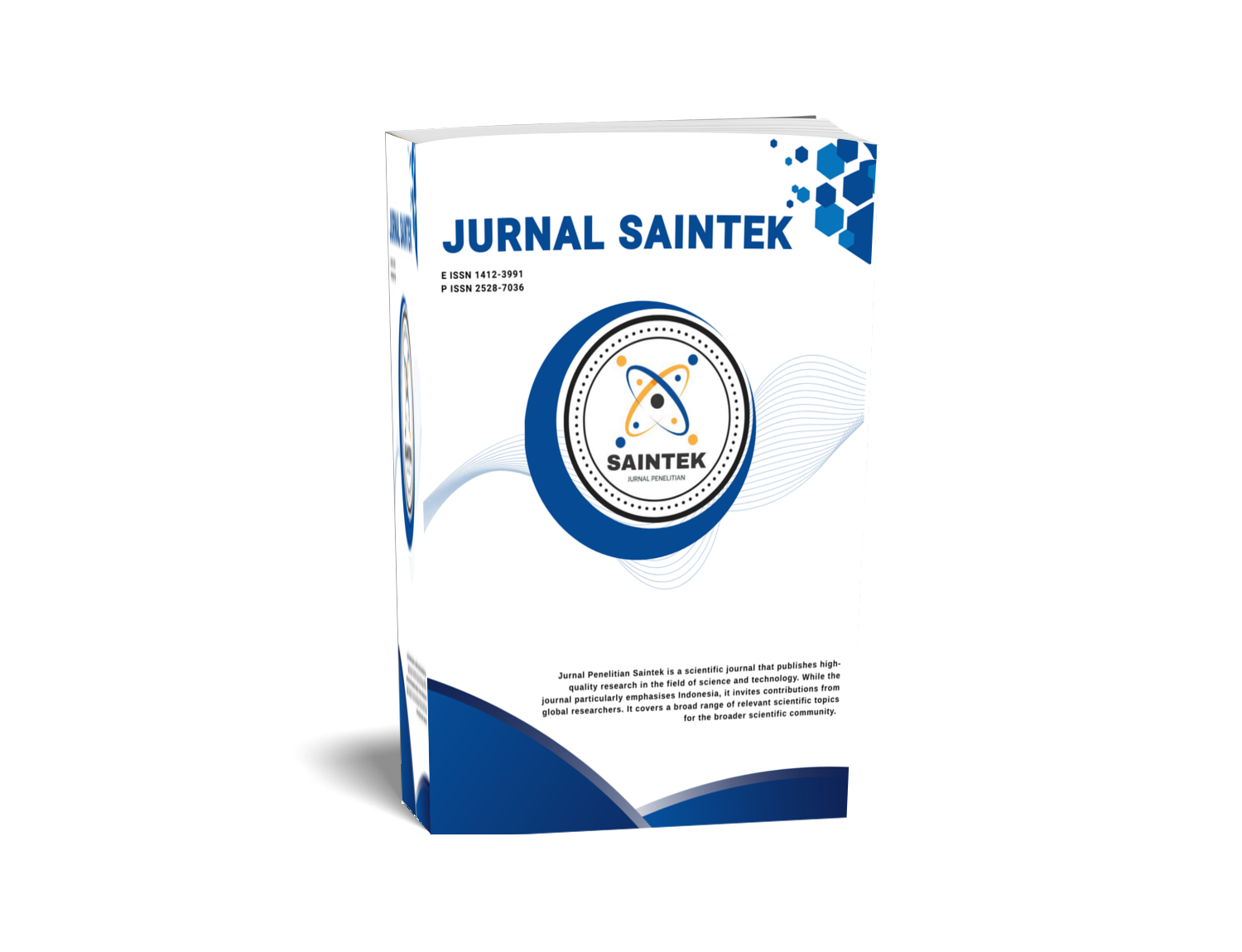SINTESIS ANALOG KURKUMIN 2,6-BIS-(E)-4-HIDROKSI-3-METOKSI BENZILIDIN)-SIKLOHEKSA-1-ON BERBAHAN DASAR VANILIN DENGAN KATALIS HCl
DOI:
https://doi.org/10.21831/jps.v25i2.34106Keywords:
analog kurkumin, 2, 6-bis-((E)-4-hidroksi-3-metoksibenzilidin)-sikloheksa-1-on, katalis HCl, kondensasi aldolAbstract
Tujuan penelitian ini memodifikasi gugus β-diketon sehingga dapat meningkatkan stabilitas dari analog kurkumin.Metode yang digunakan yaitu sintesis senyawa analog kurkumin berbahan dasar vanillin sebagai sumber benzaldehida dan sikloheksanon sebagai sumber keton dengan katalis asam (HCl). Dianalisis dengan KLT dan instrumentasi FTIR,direct-MS,1H NMR dan 13C NMR. Dari hasil analisis titik leleh, KLT, FTIR, direct-MS, 1H- dan 13C-NMR, bahwa senyawa target telah terbentuk berupa padatan warna kuning kehijauan, memiliki titik leleh 210-212 °C dan rendemen 53,00% serta hasil KLT terdapat spot baru yang berfluorosensi. Sehingga, dapat disimpulkan bahwa senyawa analog kurkumin (2,6-bis-((E)-4-hidroksi-3-metoksibenzilidin)-sikloheksa-1-on) dapat disintesis melalui kondensasi aldol menggunakan starting material vanilin sebagai sumber benzaldehida dan sikloheksanon sebagai sumber keton dengan katalis asam (HCl).
THE SYNTHESIS OF CURCUMINE ANALOGUE 2,6-BIS-(E)-4-HIDROKSI-3-METOKSI BENZILIDIN)-SIKLOHEKSA-1-ON FROM VANILIN WITH HYDROCLORIDE ACID CATALYST
The aim of this study was to modify the β-dicetone group so as to increase the stability of the curcumin analogue. The method used is the synthesis of a curcumin analogue compound based on vanillin as a source of benzaldehyde and cyclohexanone as a source of ketones with an acid catalyst (HCl). Analyzed by TLC and FTIR instrumentation, direct-MS, 1H NMR and 13C NMR. From the analysis of melting point, TLC, FTIR, direct-MS, 1H- and 13C-NMR, that the target compound has been formed in the form of a greenish yellow solid, has a melting point of 210-212 ° C and a yield of 53.00% and the results of TLC are new fluorescent spot. Thus, it can be concluded that the curcumin analogue compound (2,6-bis - ((E) -4-hydroxy-3-methoxy benzylidine) -cyclohexa-1-on) can be synthesized through aldol condensation using vanillin as a source of benzaldehyde and cyclohexanone. as a source of ketones with an acid catalyst (HCl).
References
Chattopadhyay, I., Biswas, K., Bandyo-padhyay, U., & Banerjee, R. K. (2004). Turmeric and curcumin: Biological actions and medicinal applications. CURRENT SCIENCE-BANGALORE-, 87, 44-53.
Da'i, M., Wulandari, R. R., & Utami, W. (2011). Uji aktivitas penangkap radikal DPPH analog kurkumin siklik dan N-heterosiklik monoketon, Pharmacon,12(1), 19-25.
Fessenden, R. J., & Fessenden, S. J. (1999). Kimia organik (Jilid 2). (Terj. Pudjaatmaka A. H.). Jakarta: Penerbit Erlangga.
Hawaiz, F., & Omer, S.D. (2017). Ultrasound-assisted Synthesis of Some New Curcumin Analogs and Their Corresponding Pyrazoline Derivatives. ARO-The Scientific Journal of Koya University, 5(1), 30–35. https://doi.org/10.14500/aro.10149.
Liang, R., Yuan, H., Xi, G., & Zhou, Q. (2009). Synthesis of wheat straw-g-poly (acrylic acid) superabsorbent composites and release of urea from it. Carbohydrate Polymers, 77(2), 181-187.
Liang, G., Yang, S., Jiang, L., Zhao, Y., Shao, L., Xiao, J., Ye, F., ... & Li, X. (2008). Synthesis and anti-bacterial properties of mono-carbonyl analogues of curcumin. Chemical & Pharmaceutical Bulletin, 56(2), 162-167. https://doi.org/10.1248/cpb.56.162.
Matsjeh, S., Swasono, R. T., Anwar, C., Solikhah, E. N., & Lestari, E. (2017). Synthesis of 2', 4-dihydroxy-3-methoxychalcone and 2', 4', 4-trihydroxy-3-methoxychalcone as a candidate anticancer against cervical (WiDr), colon (HeLa), and breast (T47D) cancer cell lines in vitro. AIP Conference Proceedings, 1823(1), p. 020048.
Meiyanto, E., Putri, D. D. P., Susidarti, R. A., Murwanti, R., Sardjiman, S., Fitriasari, A., ... & Kawaichi, M. (2014). Curcumin and its analogues (PGV-0 and PGV-1) enhance sensitivity of resistant MCF-7 cells to doxorubicin through inhibition of HER2 and NF-kB activation. Asian Pacific Journal of Cancer Prevention, 15(1), 179-184.
Suzana, K. A., Rudyanto, M. I. S. M., Poerwono, H., & Budiati, T. (2014). Sintesis khalkon dan derivatnya menurut reaksi kondensasi Claisen Schmidt dengan iradiasi gelombang mikro. J. Farm. dan Ilmu Kefarmasian Indonesia, 1(1), 24-27.
Syam, S., Abdelwahab, S. I., Al-Mamary, M. A., & Mohan, S. (2012). Synthesis of chalcones with anticancer activities. Molecules, 17(6), 6179-6195.
Yuan, X., Li, H., Bai, H., Su, Z., Xiang, Q., & Wang, C. (2014). Synthesis of novel curcumin analogues for inhibition of properties. European Journal of Medicinal Chemistry, 77, 223-230. https://doi.org/10.1016/j.ejmech.2014.03.012.
Downloads
Published
How to Cite
Issue
Section
Citation Check
License
Who Can Submit?
Any individual may submit an original manuscript for consideration for publication in Jurnal Penelitian Saintek as long as they hold the copyright to the work or are authorized by the copyright owner(s) to submit it. Authors retain initial ownership of the copyrights to their works prior to publication, except in cases where, as a condition of employment, they have agreed to transfer copyright to their employer.
User Rights
Jurnal Penelitian Saintek is an Open Access journal. Users are granted the right to read, download, copy, distribute, print, search, or link to the full texts of articles, provided they comply with the conditions of the Creative Commons Attribution-ShareAlike License 4.0 (CC BY-SA 4.0).
https://creativecommons.org/licenses/by-sa/4.0/
Author Rights
Authors retains copyrights.
Jurnal Penelitian Saintek by http://journal.uny.ac.id/index.php/saintek is licensed under a Creative Commons Attribution-ShareAlike 4.0 International License.









